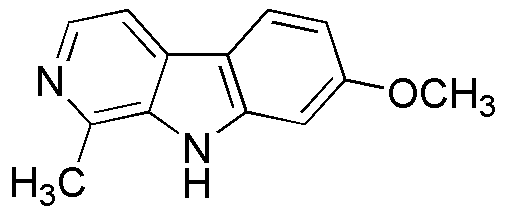Harmine is widely utilized in research focused on:
- Neuroscience: Harmine has shown potential in neuroprotective studies, aiding in the understanding of neurodegenerative diseases like Alzheimer's and Parkinson's. Researchers explore its ability to promote neuronal health and function.
- Pharmacology: This compound is investigated for its psychoactive properties, particularly in the context of mental health treatments. Its role as a monoamine oxidase inhibitor (MAOI) makes it a candidate for developing therapies for depression and anxiety.
- Traditional Medicine: Harmine is a key component in various herbal remedies, particularly in South American indigenous practices. Its applications in holistic healing and spiritual rituals are of interest to ethnobotanists and alternative medicine practitioners.
- Cancer Research: Studies are exploring harmine's potential anti-cancer properties. It has been observed to inhibit the growth of certain cancer cell lines, making it a subject of interest for developing new cancer therapies.
- Biotechnology: In the field of synthetic biology, harmine is being examined for its role in gene expression modulation. This application could lead to advancements in genetic engineering and biotechnology innovations.
General Information
Properties
Safety and Regulations
Applications
Harmine is widely utilized in research focused on:
- Neuroscience: Harmine has shown potential in neuroprotective studies, aiding in the understanding of neurodegenerative diseases like Alzheimer's and Parkinson's. Researchers explore its ability to promote neuronal health and function.
- Pharmacology: This compound is investigated for its psychoactive properties, particularly in the context of mental health treatments. Its role as a monoamine oxidase inhibitor (MAOI) makes it a candidate for developing therapies for depression and anxiety.
- Traditional Medicine: Harmine is a key component in various herbal remedies, particularly in South American indigenous practices. Its applications in holistic healing and spiritual rituals are of interest to ethnobotanists and alternative medicine practitioners.
- Cancer Research: Studies are exploring harmine's potential anti-cancer properties. It has been observed to inhibit the growth of certain cancer cell lines, making it a subject of interest for developing new cancer therapies.
- Biotechnology: In the field of synthetic biology, harmine is being examined for its role in gene expression modulation. This application could lead to advancements in genetic engineering and biotechnology innovations.
Documents
Safety Data Sheets (SDS)
The SDS provides comprehensive safety information on handling, storage, and disposal of the product.
Product Specification (PS)
The PS provides a comprehensive breakdown of the product’s properties, including chemical composition, physical state, purity, and storage requirements. It also details acceptable quality ranges and the product's intended applications.
Certificates of Analysis (COA)
Search for Certificates of Analysis (COA) by entering the products Lot Number. Lot and Batch Numbers can be found on a product’s label following the words ‘Lot’ or ‘Batch’.
*Catalog Number
*Lot Number
Certificates Of Origin (COO)
This COO confirms the country where the product was manufactured, and also details the materials and components used in it and whether it is derived from natural, synthetic, or other specific sources. This certificate may be required for customs, trade, and regulatory compliance.
*Catalog Number
*Lot Number
Safety Data Sheets (SDS)
The SDS provides comprehensive safety information on handling, storage, and disposal of the product.
DownloadProduct Specification (PS)
The PS provides a comprehensive breakdown of the product’s properties, including chemical composition, physical state, purity, and storage requirements. It also details acceptable quality ranges and the product's intended applications.
DownloadCertificates of Analysis (COA)
Search for Certificates of Analysis (COA) by entering the products Lot Number. Lot and Batch Numbers can be found on a product’s label following the words ‘Lot’ or ‘Batch’.
*Catalog Number
*Lot Number
Certificates Of Origin (COO)
This COO confirms the country where the product was manufactured, and also details the materials and components used in it and whether it is derived from natural, synthetic, or other specific sources. This certificate may be required for customs, trade, and regulatory compliance.

